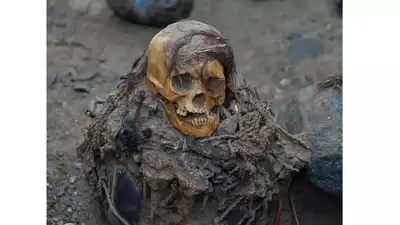ARTICLE AD BOX

In a stunning archaeological find, a 1,000-year-old mummy has been discovered just over a metre below ground during a routine gas pipeline installation in Lima, Peru. The remains, believed to be of a boy aged 10 to 15, were remarkably well-preserved, with brown hair still visible and the body found in a formal seated posture with bent arms and legs.
Wrapped in a shroud alongside ceremonial objects, the mummy is thought to belong to the pre-Inca Chancay culture. Experts say the burial offers rare insight into ancient funerary practices on Peru's coast and the natural preservation effects of desert heat.
Seated mummy discovered during gas pipeline work
The remarkable discovery was made by gas company workers from Calidda while laying pipes in a residential part of Lima. Following Peru’s rigorous heritage regulations, archaeologists were immediately called in to investigate the site.
The mummy was found just 1.2 metres beneath the surface, highlighting how shallow yet significant archaeological layers can exist beneath modern cities. This unplanned find underscores the importance of routine archaeological oversight during all construction activities in culturally rich zones.

Burial aligned with Chancay cultural practices
Archaeologists have identified the burial as consistent with the Chancay culture, which thrived on Peru’s central coast between 1,000 and 1,470 AD.
The seated position, bent limbs, and wrapping in a fabric shroud are all hallmarks of Chancay funerary rituals. Intriguingly, a native huarango tree trunk was found next to the body, believed to have functioned as a symbolic tomb marker. This practice reflects the Chancay's spiritual beliefs and the significance they placed on marking sacred burial spaces within their communities.

Accompanying artefacts and symbolic items
Several ritual and domestic artefacts were found surrounding the mummy, including calabash gourds etched with fine artwork, and ceramic vessels decorated with geometric shapes and fishing motifs.
These items likely served both spiritual and practical functions, either as offerings to aid the deceased in the afterlife or as indicators of the individual’s social status or occupation. The iconography of marine life strongly suggests a connection to a coastal fishing community, common in Chancay settlements.
Natural mummification in Peru’s desert climate
Experts attribute the mummy’s exceptional state of preservation to Peru’s arid coastal climate. The extreme dryness dehydrates bodies rapidly, naturally halting decomposition.
According to archaeologist Pieter Van Dalen, this type of natural mummification is common in the region and explains why many mummies retain features like hair, skin, and even clothing. Unlike the complex embalming methods used in Egypt, Peruvian mummies are often preserved by their environment alone.
Lima’s archaeological depth
Today’s bustling capital of Lima is built atop layers of ancient history. Before Spanish colonisation in the 16th century, the area was inhabited by several advanced cultures.
There are more than 500 documented archaeological sites scattered across the city, ranging from burial grounds and ceremonial pyramids to ancient settlements. As urban development continues, it is not unusual for modern infrastructure projects to unearth relics from Peru’s distant past—sometimes just inches beneath the surface.
A window into ancient lives
This mummy provides more than just a glimpse into burial practices—it opens a valuable window into the daily lives, beliefs, and cultural expressions of the Chancay people. Researchers are currently analysing the artefacts and remains to better understand the social structure, diet, and health conditions of the era. Future studies may also yield DNA and isotopic data, offering further clues about the individual’s origins, lifestyle, and possibly even family lineage.
Such discoveries continue to deepen our understanding of Peru’s pre-Columbian civilizations.



.png)
.png)
.png)
















 3 hours ago
5
3 hours ago
5









 English (US) ·
English (US) ·